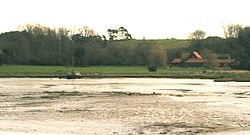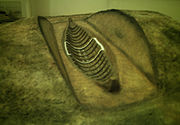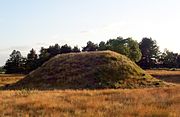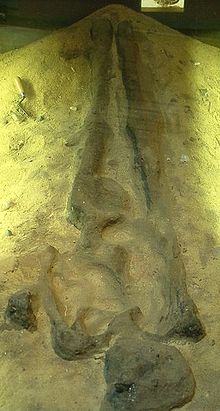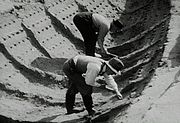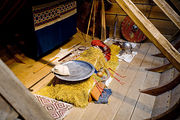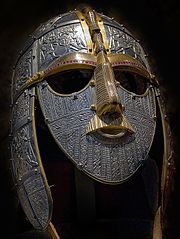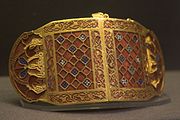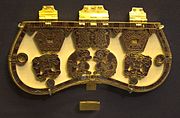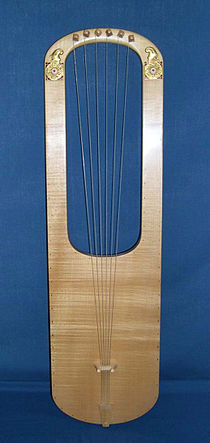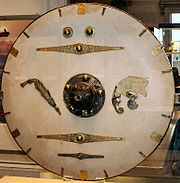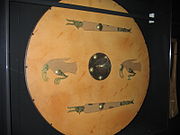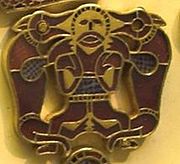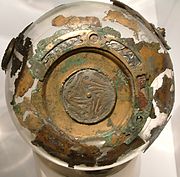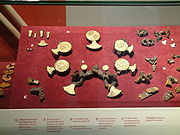
Sutton Hoo
Background Information
The articles in this Schools selection have been arranged by curriculum topic thanks to SOS Children volunteers. Click here for more information on SOS Children.
Sutton Hoo near Woodbridge, Suffolk, England, is the site of two Anglo-Saxon cemeteries of the 6th century and early 7th century. One contained an undisturbed ship burial including a wealth of Anglo-Saxon artefacts of outstanding art-historical and archaeological significance, which are now held in the British Museum in London. Other sites before then had already produced significant finds, but many had been looted.
Sutton Hoo is of a primary importance to early medieval historians because it sheds light on a period of English history which is on the margin between myth, legend and historical documentation. Use of the site culminated at a time when Rædwald, the ruler of East Anglia, held senior power among the English people, and played a dynamic if ambiguous part in the establishment of Christian rulership in England; it is generally thought most likely that he is the person buried in the ship. The site has been vital in understanding the Anglo-Saxon Kingdom of East Anglia and the whole early Anglo-Saxon period.
The ship-burial, probably dating from the early 7th century and excavated in 1939, is one of the most magnificent archaeological finds in England for its size and completeness, far-reaching connections, the quality and beauty of its contents, and for the profound interest of the burial ritual itself. The initial excavation was privately sponsored by the landowner, but when the significance of the find became apparent, national experts took over. Subsequent archaeological campaigns, particularly in the late 1960s and late 1980s, have explored the wider site and many other individual burials. The most significant artefacts from the ship-burial, displayed in the British Museum, are those found in the burial chamber, including a suite of metalwork dress fittings in gold and gems, a ceremonial helmet, shield and sword, a lyre, and many pieces of silver plate from the Eastern Roman Empire. The ship-burial has from the time of its discovery prompted comparisons with the world described in the heroic Old English poem Beowulf, which is set in southern Sweden. It is in that region, especially at Vendel, that close archaeological parallels to the ship-burial are found, both in its general form and in details of the military equipment that the burial contains.
Although it is the ship-burial which commands the greatest attention from tourists, there is also rich historical meaning in the two separate cemeteries, their position in relation to the Deben estuary and the North Sea, and their relation to other sites in the immediate neighbourhood. Of the two gravefields found at Sutton Hoo, one (the "Sutton Hoo cemetery") had long been known to exist because it consists of a group of around 20 earthen burial mounds which rise slightly above the horizon of the hill-spur when viewed from the opposite bank. The other, called here the "new" burial ground, is situated on a second hill-spur close to the present Exhibition Hall, about 500 m upstream of the first, and was discovered and partially explored in 2000 during preparations for the construction of the hall. This also had burials under mounds, but was not known because they had long since been flattened by agricultural activity. The site has a visitor's centre, with many original and replica artefacts and a reconstruction of the ship burial chamber, and the burial field can be toured in the summer months.
Location
Sutton Hoo is the name of an area spread along the bluffs on the eastern bank of the River Deben opposite the harbour of Woodbridge. The word "hoo" means "spur of a hill." About 7 miles (11 km) from the sea, it overlooks the inland waters of the tidal estuary a little below the lowest convenient fording place. The tidal reaches of the Deben form one of a group of estuaries which drain from the south-eastern side of the county of Suffolk into the North Sea. These river estuaries formed paths of entry to East Anglia during the continental migrations to Britain of the 5th and 6th centuries, following the end of Roman imperial rule, and their control was important both in Roman and Anglo-Saxon times. A Roman stone shore-fort stood on high ground near the mouth of the Deben on the south side, at Walton, near Felixstowe, and was a prominent feature in Anglo-Saxon times: it is one of the two claimed sites for the original East Anglian bishopric of Dommoc, founded c. 630. Fifth century artefacts, including late Roman belt equipment and early continental brooches, have been found at Shottisham (south of Sutton Hoo).
A little way south of Woodbridge the tidal Martlesham Creek emerges into the Deben on the west side, fed from valleys with 6th century burial grounds at Rushmere, Little Bealings and Tuddenham St Martin, and circling Brightwell Heath, the site of several Bronze Age and later mounds. Further up the Deben, on bluffs overlooking the brackish reaches, were cemeteries of similar date at Rendlesham and Ufford. A large cemetery of mixed cremation and inhumation burials stood in a similar position to Sutton Hoo at Snape, above the fordable headwaters of the river Alde. This also contained a large ship-burial, the only other burial in England comparable to the famous examples at Sutton Hoo.
Within thirty years after the ship-burial at Sutton Hoo, an important early monastery was founded by royal grant at Iken beside the Alde in 654 for Saint Botolph. In c. 660 Rendlesham is definitely identified by Bede as the site of a vicus regius (royal dwelling) of King Aethelwold of the Wuffinga dynasty of the East Angles, and may have had a similar use at an earlier date; Rendlesham has a church dedication to Gregory the Great, the pope who sent the Roman Christian mission to England which arrived in Kent in 597.
By the early tenth century the entire region between the Orwell and the watersheds of the Alde and Deben rivers was known as the "Wicklaw". It is suggested that this represents an early administrative region or regio, originally centred upon Rendlesham or Sutton Hoo as the node of estuarine control, and was one of the primary components in the formation of the Kingdom of East Anglia. Also in the early 7th century, Gipeswic (Ipswich), at the fordable headwaters of the Orwell estuary, began its growth as the primary centre for maritime trade in East Anglia, with Rhineland contacts so that the instruments and resources of royal power were focussed in this immediate neighbourhood.
Archaeology
Excavations up to 1930s
The burial ground with visible mounds has experienced diggings since at least the 16th century and was extensively dug into during the 19th century, with a small platform at one side for viewing, though without any useful records being made. Mound 1, unlike most of the other mounds at Sutton Hoo, had remained largely untouched by treasure seekers since the burial. In medieval times the site had been divided by boundary ditches to form fields. One of those ditches cut across the western side of Mound 1, shortening its length. A pit dug in the 16th century, dated by bottle shards left at the bottom, had been sunk at the apparent centre, missing the real centre and the burial deposit by a narrow lateral margin, though it was also not deep enough. In 1860 it was reported that nearly two bushels of iron screw bolts, presumably ship rivets, had been found at the recent opening of a mound, and that it was hoped to open others.
1938 dig
The site had been arable land in the 19th century but by the 1930s had returned to heathland. A large house had been built a few hundred yards from the mounds in 1910, lived in by Mrs Edith May Pretty, the owner of the estate. Around 1900 an elderly resident of Woodbridge had spoken of "untold gold" in the Sutton Hoo mounds, and Mrs Pretty's nephew, a dowser, repeatedly identified signals of buried gold from what is now known to be the ship-mound. Pretty became interested in Spiritualism, and was encouraged by friends who claimed to see figures at the mounds. Through the Ipswich Museum, in 1937 she obtained the services of Basil Brown, a Suffolk man who had taken up full-time archaeology on Roman sites for the museum. Pretty took Brown to the site, and suggested that he start digging at Mound 1, one of the largest. The mound had obviously been disturbed, and in consultation with Ipswich Museum, Brown decided instead to open three smaller mounds (2, 3 and 4) during 1938 with the help of three estate labourers. These did reveal interesting treasures, but only in fragments as the mounds had been robbed. In the larger Mound 2 he found iron ship-rivets and a disturbed chamber burial with fragments of metal and glass artefacts. The rituals and objects revealed were unusual, and at first it was undecided if they were of Viking Age or early Anglo-Saxon date. These finds are held by Ipswich Museum.
1939 dig
Mrs Pretty still wanted a full excavation of Mound 1 and, in May 1939, Brown began work helped by the gamekeeper and the gardener. Driving a trench from the east end they discovered ship-rivets in position, and the colossal size of the find began to dawn on them. After patient weeks of clearing out earth from within the ship's hull they reached the burial chamber and realised it was undisturbed. It lay beneath the exact spot where Mrs Pretty had told him to dig a year previously.
In June 1939 Charles Phillips of Cambridge University, hearing rumours of a ship discovery, visited Ipswich Museum and was taken by Mr Maynard, the curator, to the site. Staggered by what he now saw, within a short time Phillips, in discussion with the Ipswich Museum, the British Museum, the Science Museum, and Office of Works undertook the excavation of the burial chamber. He assembled a team of experts including W.F. Grimes and O.G.S. Crawford of the Ordnance Survey, Stuart and Peggy Piggot and others. Basil Brown continued to clear the ship. Mrs Pretty sent Brown to a spiritualist meeting in Woodbridge, where the medium had an intimation of his discovery.
The need for secrecy and various vested interests led to confrontation between Phillips and the Ipswich Museum. The museum's honorary president, Reid Moir F.R.S., had been a founder of the Prehistoric Society of East Anglia in 1908, and the curator, Mr Maynard, was its secretary and editor from 1921. In 1935–6 Charles Phillips and his friend (Sir) Grahame Clark had taken control of the society. Maynard then turned his attention to developing Brown's work for the museum. Phillips, who was hostile towards Moir, had now reappeared, and he deliberately excluded Moir and Maynard from the new discovery.
The whole excavation was overshadowed by the imminent war with Germany. The finds, having been packed and removed to London, were brought back for a treasure trove inquest held in the autumn at Sutton village hall, where it was decided that since the treasure was buried without the intention to recover it, it was the property of Mrs Pretty as landowner. Pretty decided to bequeath the treasure as a gift to the whole nation, so that the meaning and excitement of her discovery could be shared by everyone.
In spring 1939 Brown drove a trench through Mound 1 and discovered the replaced wood stain and undisturbed rivets of the ship-burial. After the intervention described above, through the late summer a team led by Charles Phillips elucidated the burial chamber amidships and removed the treasure. As the astounding golden and silver treasures emerged it became certain this was an early 7th century find of greater quality than any hitherto discovered. Afterwards the hollow mound was lined with bracken and turf for protection. During the War the grave-goods were put in storage and the site was used as a training ground for military vehicles. Phillips and colleagues produced important publications in 1940.
1965-1971
Rupert Bruce-Mitford led the Sutton Hoo research team at the British Museum. They completely re-excavated Mound 1 in 1965–1971 to resolve certain problems posed by the first discovery. The ship impression was again exposed and a plaster cast taken, from which a fibre-glass shape was produced. The mound was afterwards restored to its pre-1939 appearance. The limits of Mound 5 were also determined, and evidence of prehistoric activity on the original land-surface was investigated by Ian Longworth. Meanwhile the British Museum Conservation team under Harold Plenderleith, Herbert Maryon and Nigel Williams performed the work of scientific analysis and reconstruction of the finds. The definitive text, The Sutton Hoo Ship Burial by Bruce-Mitford, was finally published in three volumes in 1975, 1978, and 1983.
1983-1992
The investigation of 1983–1992 was directed by Professor Martin Carver ( University of York) for the Sutton Hoo Research Trust, on behalf of the British Museum and the Society of Antiquaries of London. The site was thoroughly surveyed and new techniques were developed. Topsoil was stripped across an area of the site around and including Mounds 2, 5, 6, 7, 17 and 18 to produce a map of soil patterns and intrusions. This showed that the mounds had been sited in relation to earlier (prehistoric and Roman) enclosure patterns. A series of Anglo-Saxon graves of execution victims were found, and determined to be younger than the primary mounds. Mound 2 was re-explored and reconstructed to its supposed Anglo-Saxon form. Mound 17, a previously undisturbed burial, contained a young man with weapons and goods, alongside a separate grave containing a horse. Publication of this work was completed in 2005.
A substantial part of the gravefield has not been disturbed in modern times, but is reserved for the benefit of future investigators and future scientific methods: for example it would have been possible in a modern excavation to find chemical traces of the body in the ship-burial, using techniques not developed in the 1940s.
The site
The barrows
The field contains about 20 barrows. Professor Carver's excavation established that this was no general burying-ground, but was reserved for a select group of individuals buried with objects denoting unusual wealth or prestige. This was unlike the Snape cemetery, where a ship-burial and other furnished graves were added to an older existing graveyard of human ashes buried in pots. Most had been cremated, and each barrow was raised to commemorate one particular person. It was used in this way for about 50 to 60 years during the last quarter of the sixth and the first quarter of the 7th centuries. Almost all of these graves had been plundered. The mounds are discussed in thematic, not numeric order, below, because the numbering reflects the excavation history rather than the original deposition of the burials.
- Cremation graves and minor inhumations
Of the two cremations excavated in 1938 Mound 3 contained the ashes of a man and a horse placed on a wooden trough or dugout bier, together with an iron-headed throwing-axe, a Frankish weapon. The grave also contained objects imported from the eastern Mediterranean area, including the lid of a bronze ewer, part of a miniature carved plaque depicting a winged Victory, and fragments of decorated bone from a casket of similar origin. The other, Mound 4, was the cremation of a man and a woman with a horse and perhaps also a dog. This included a few fragments of bone gaming-pieces.
In Mounds 5, 6 and 7 Professor Carver found three cremations deposited in bronze bowls with a variety of goods. The man in Mound 5 had died from weapon blows to the skull. With him some gaming-pieces, small iron shears, a cup and an ivory box with sliding lid had escaped the looters' attention. Mound 7 was the remains of a grand cremation, in which horse, cattle, red deer, sheep and pig had been burnt with the deceased on the pyre. His goods had included gaming-pieces, an iron-bound bucket, a sword-belt fitting and a drinking vessel. Mound 6, similarly, was accompanied by cremated animals, gaming-pieces, a sword-belt fitting and a comb. The Mound 18 grave was very damaged, but of similar kind.
One urned and one unurned cremation were found during the 1960s exploration to define the extent of Mound 5, together with two inhumations and a pit with a skull and fragment of decorative foil. In level areas between the mounds Professor Carver found three furnished inhumations not of execution victims. One under a small mound held a child's body with a buckle and a miniature spear. The grave of a man included two belt-buckles and a knife, and that of a woman contained a leather bag, a ring-headed pin and a chatelaine.
- Mound 17 – the equestrian grave
Most impressive of the burials not contained in a chamber is the Mound 17 grave of a young man and his horse. They were in fact two separate grave-hollows side by side under a single mound, and were undisturbed (looters had dug over the intervening baulk). The man was buried in an oak coffin with his pattern welded sword at his right side. The sword-belt was wrapped around the blade, with a bronze buckle with garnet cloisonné cellwork, two pyramidal strapmounts and a scabbard-buckle. By his head were a strike-a-light and a leather pouch containing rough garnets and a piece of millefiori glass. Around the coffin were two spears, a shield, a small cauldron and bronze bowl, a pot and an iron-bound bucket. Some animal ribs were probably a food offering. In the north-west corner of the man's grave was the bridle for the horse, mounted with circular gilt bronze plaques bearing deftly-controlled interlace ornament. These are displayed in the Exhibition Hall at Sutton Hoo.
Inhumation graves containing a man and horse together, signifying an equestrian role, are known from England and Germanic Europe. Most are of the sixth or early seventh century. Two Suffolk examples have been excavated at Lakenheath in western Suffolk, and another found in c 1820 is recorded from Witnesham near Ipswich. There is an example in the Snape cemetery. Others are inferred from records of the discovery of horse furniture in cemetery contexts at Eye and Mildenhall. Presumably the horse was sacrificed for the funeral. The ritual is sufficiently standardised to indicate that it reflects formal status rather than sentimental attachment.
- Mound 14 – a woman's chamber-grave
Although this grave had been destroyed almost completely by robbing, apparently during a heavy rainstorm, it had contained exceptionally high quality goods belonging to a woman. These included a chatelaine, a kidney-shaped purse lid, a bowl, several buckles, a dress-fastener and the hinges of a casket, all made of silver, and also a fragment of embroidered cloth.
- Mound 2 – a man's chamber-grave covered with a ship
This extremely important grave, very damaged by looters, was excavated in 1938 by Basil Brown. It was probably the source of the many iron ship-rivets found in 1860. Brown, having found similar rivets dispersed in the mound, interpreted the burial, by comparison with the Snape find, as a small boat with square stern containing the grave deposit. Professor Carver's very thorough re-investigation revealed that this was essentially a rectangular plank-lined chamber, 5 m long by 2 m wide, sunk below the land surface with the body and grave-goods laid out in it. A ship, probably a smaller version of the Snape or Sutton Hoo Mound 1 type, was then placed over it, aligned east and west, before a large earth mound was raised above the whole.
Chemical analysis of the chamber floor suggested the presence of a body in the south-western corner. The goods, although very fragmentary, included an English blue glass cup with trailed decoration, like those from various English chamber-graves, including the recent find from the Royal Saxon tomb in Prittlewell, Essex. There were also two gilt-bronze discs with animal interlace ornament, a bronze brooch, a silver buckle, a gold-coated stud from a buckle and other items. Apart from the boat, four of the objects have a special kinship to those from the Mound 1 ship-burial. The tip of a swordblade showed elaborate pattern-welding similar to the Mound 1 sword: silver-gilt drinking horn mounts were struck from the same dies as the Mound 1 horn-mounts: and two fragments of dragonlike mounts or plaques probably derived from a large shield of a type resembling one found at an excavation at the village of Vendel in east Sweden (see below), and similar to the Mound 1 shield. Although the rituals were not identical, the association of these objects and the ship in this grave shows an immediate connection between the two burials.
- The execution burials (or "sandmen")
In contrast to the high status evident from these finds, the cemetery also contained a number of inhumations of a very different character. These were of people who had died by violent means, in some cases clearly by hanging or beheading. Often the bones had not survived, but this important part of the site's history was recovered by a special technique during the 1980s excavations. The fleshy parts of the bodies had left a stain in the sandy soil: this was laminated as work progressed, so that finally the emaciated figures of the dead were revealed. Casts were taken of several of these tableaux.
The identification and discussion of these burials has been led by Professor Carver. Two main groups were excavated, one arranged around Mound 5, and the other beyond the barrow cemetery limits in the field to the east. It is thought that a gallows stood on Mound 5, a prominently visible position near a significant river-crossing point, and that these were victims of judicial execution. The executions are evidently later than Mound 5, and possibly date mostly from the 8th and 9th centuries.
- Mound 1 – the ship-burial
New gravefield
During the year 2000 an excavation was made by a Suffolk County Council team on the site intended for the National Trust visitor centre. The site lies some distance north of Tranmer House, at a point where the ridge of the Deben valley veers westwards to form a promontory and a south-western prospect across the river is afforded. A large area of topsoil was removed, in one corner of which a number of early Anglo-Saxon burials were discovered, some being furnished with objects of high status. The following discoveries were of particular note.
- The "Bromeswell bucket"
Attention was first attracted to this area by the chance discovery of a rare imported artefact of eastern Mediterranean origin of the 6th century. It is part of a vessel of thin beaten bronze with vertical sides, made to contain beverage. The outer surface is decorated with a frieze of Syrian or Nubian style depicting naked warriors carrying swords and shields in combat with leaping lions, executed by punch-marking. Above the frieze and below the rim is a zone of inscription in Greek lettering which translates "Use this in good health, Master Count, for many happy years." This is very likely to have derived from a furnished burial.
- Group of cremation mounds
In an area near to Mrs Pretty's former rose garden a group of moderate-sized burial mounds was identified. The mounds had long since been levelled, but their position was shown by circular surrounding ditches. At the centre of each was a small deposit indicating the presence of a single burial, probably of unurned human ashes.
- Cremation burial with hanging bowl
This burial lay in an irregular ovate pit which contained two vessels. One was a stamped black earthenware urn of late 6th century type. The other was a large bronze hanging bowl in excellent condition, with openwork hook escutcheons (without enamel) and a related circular mount at the centre of the bowl. The mounts are very similar to an example found at Eastry, Kent, possibly from a 7th century royal dwelling.
- "Warrior" inhumation
In this burial a man was laid out with a spear at his side and a shield of normal size over him. The shield bore two fine metal mounts, one depicting a predatory bird (not unlike the shield from the ship) and the other a thin dragonlike creature, and the boss-stud was also ornamented. The Vendel-type connections with Mound 1 were significant.
Ship-burial
The ship-burial is one of the most magnificent archaeological finds in England for its size and completeness, far-reaching connections, the quality and beauty of its contents, and for the profound interest of the burial ritual itself. The most significant artefacts from the ship-burial, displayed in the British Museum, are those found in the burial chamber, including a suite of metalwork dress fittings in gold and gems, a ceremonial helmet, shield and sword, a lyre, and many pieces of silver plate from the Eastern Roman Empire.
The burial
- Ship
Although practically none of the original timber survived, the excavated form of the ship in Mound 1 presented a very perfect image in 1939. A stain in the sand had replaced the wood but had preserved many details of the construction, and nearly all of the iron planking rivets remained in their original places. Hence it was possible to survey and describe what was merely a ghost of the original ship. It was about 27 m (c 90 feet) long, pointed at either end with tall rising stem and stern posts, widening to about 4.4 m (c 14 feet) in the beam amidships with an inboard depth of about 1.5 m (c 4 ft 10 ins) over the keel line. From the keel board the hull was constructed clinker-fashion with nine planks on either side, the overlaps fastened with rivets. Twenty-six wooden frames strengthened the form within, more numerous near the stern where a steering-oar might be attached. Repairs were visible: this had been a seagoing vessel of excellent craftsmanship, but there was no descending keel.
- Burial-chamber
This oak vessel of many tons weight had been hauled a considerable distance from the river to the brow of the hill, the prow facing inland to the east, and lowered into a prepared trench, so that only the tops of the stem and stern posts, some 4 m (c 13 feet) above the lowest part of the hull, rose above the land surface. The decking, benches and whatever mast there may have been were removed. In the fore and aft sections, thorn-shaped wooden oar-rests were visible along the gunwales. If these were originally continuous along either side there would have been positions for forty oarsmen. However they were absent (perhaps removed) in the central section, where a chamber for the burial was constructed. This occupied a length of about 5.5 m (c 17 feet) amidships: timber walls were constructed at either end (the hull forming the side walls) and a roof, probably pitched like a house, was mounted above.
- Position of the body
The excavators found no trace of a body, and originally suggested that the grave was a form of cenotaph. However the arrangement and type of the buried goods, and the knowledge that these soils do dissolve bone, left little doubt that this was a burial with a body, and that it was placed in the centre of the chamber with the feet to the east. A phosphorus survey indicated higher levels of phosphorus in the area supposed to have been occupied by the body. Some long time, perhaps many decades, after the burial the roof collapsed violently under the weight of the mound, compressing the goods into a seam of earth. The body lay on or in a central wooden structure about 9 feet long, possibly a platform or a very large coffin; interpretations vary. An ironbound wooden bucket stood on the south side of this, and an iron lamp containing beeswax and a small wheel-thrown bottle of north continental make at its south-east corner.
- The mound
After the addition of the body and the artefacts described in the next section, the burial was completed by the construction of a long and high oval mound which not only completely covered the ship but rose above the horizon at the west or riverward side of the Sutton Hoo cemetery. Although the view to the river is now obscured by Top Hat Wood, it was doubtless originally intended that the mound should brood visibly on the bluff above the river as an outward symbol of power to those using the waterway. On present evidence, this magnificent funeral appears to have been the final occasion upon which the Sutton Hoo cemetery was used for its original purpose.
Long after the mound was raised the westerly end of it was dug away when a mediaeval boundary ditch was laid out. Therefore when looters dug into the apparent centre during the sixteenth century they missed the real centre: nor could they have foreseen that the deposit lay very deep in the belly of a buried ship, well below the level of the land surface. Great pains had been taken to ensure that it remained undisturbed for a very long time.
Objects in the burial-chamber
- Helmet, silver bowls and spoons (head area)
The objects around the likely position of the body indicate that it lay with the head close to the west end of the central wooden structure. On the head's left side was placed the "crested" and masked helmet, wrapped in cloths. With its historiated die-struck panels of tinned bronze and assembled mounts the decoration of the helmet is directly comparable to that found on helmets from the Vendel and Valsgärde cemeteries of eastern Sweden. The Sutton Hoo helmet differs from the Swedish examples in having an iron skull of a single vaulted shell and not of a composite construction. It also differs in having a full face mask, a solid neck guard and deep cheekpieces. These features have suggested an English rather than Swedish origin for the non-decorative basic structure of the helmet; the deep cheekpieces have parallels in another English helmet, found in York, the Coppergate helmet. Although outwardly very like the Swedish examples, the Sutton Hoo helmet is a product of superior quality craftsmanship. Helmets are extremely rare finds. No other such figural plaques are known in England, apart from a fragment from a burial at Caenby, Lincolnshire. The helmet rusted in the grave and was shattered into hundreds of tiny fragments when the chamber roof collapsed. Restoration of the helmet thus involved the meticulous identification, grouping and orientation of the surviving fragments before reconstruction over a head mannequin.
To the head's right was placed inverted a nested set of ten silver bowls, probably made in the Eastern Empire during the sixth century. Beneath them were two silver spoons, possibly from Byzantium itself, of a type bearing names of the Apostles. One spoon is marked in original nielloed Greek lettering with the name of PAVLOC, "Paul". The other, matching spoon has been modified using lettering conventions of a Frankish coin-die cutter, to read CAVLOC, "Saul". A disputed theory suggests that the spoons and possibly also the bowls formed a baptismal gift for the buried person, alluding to the Damascene conversion of Saint Paul ( Acts Ch. 9 & 13.9).
- Sword, sword-harness and spears (right side)
Parallel with the body space on the right hand lay a set of spears, tips uppermost, including three barbed angons, their heads thrust through a handle of the bronze bowl in the northeast corner. Nearby was a wand with a small mount depicting a wolf. Closer to the body lay the sword with gold and garnet cloisonné pommel (85 cm or 34in long), its pattern-welded blade within its scabbard. Attached to this and lying towards the body was the sword harness and belt, fitted with a suite of solid gold mounts and strap-distributors of extremely intricate garnet cellwork ornament. The scabbard-bosses of domed cellwork and pyramidal mounts with faceted stones in the angles are also superlative.
- Purse, shoulder-clasps and great buckle (upper body area)
Together with the sword harness and scabbard mounts, the gold and garnet objects found in the upper body space are among the true wonders of Sutton Hoo. Their artistic and technical quality is quite exceptional. They form a co-ordinated ensemble thought to have been produced for this wearer as patron.
The "great" gold buckle is made in three parts. The plate is a long ovoid of meandering but symmetrical outline with densely interwoven and interpenetrating Style II ribbon animals rendered in chip-carving on the front. The gold surfaces are punched to receive niello detail. The plate is hollow and has a hinged back, forming a secret chamber possibly for a relic. Both the tongue-plate and hoop are solid, ornamented, and expertly engineered. Garnet is not employed in this object.
Each shoulder-clasp consists of two matching curved halves, hinged upon a long removable chained pin. The surfaces display panels of interlocking stepped garnets and chequer millefiori insets, surrounded by interlaced ornament of Germanic Style II ribbon animals. The half-round clasp ends contain garnet-work of interlocking boars with filigree surrounds. On the underside of the mounts are lugs for attachment to a stiff leather cuirass. The function of the clasps is to hold together the front and back halves of such armour so that it can fit the torso closely in the Roman manner. The cuirass itself, possibly worn in the grave, did not survive. No other Anglo-Saxon cuirass clasps are known.
The purse, with ornamental lid covering a lost leather pouch, hung from the waist-belt. The lid consists of a kidney-shaped cellwork frame enclosing a sheet of horn, on which were mounted pairs of exquisite garnet cellwork plaques depicting predatory birds, wolves devouring men, geometric motifs, and a double panel showing horses or animals with interlaced extremities. The maker derived these images from the ornament of the Swedish-style helmets and shield-mounts. In his work they are transferred into the cellwork medium with dazzling technical and artistic virtuosity.
These are therefore the work of a master-goldsmith of his age who had access to an East Anglian armoury containing the objects used as pattern sources. As an ensemble they enabled the patron to appear in an imperial persona, and expressed his authority and resources to do so.
The purse contained 37 gold shillings or tremisses, each from a different Frankish mint and therefore deliberately formed as a collection. There were also three blank coins and two small ingots. This has prompted various explanations. Possibly like the Roman "obolus" they were to pay the forty ghostly oarsmen in the afterworld, or were a funeral tribute, or an expression of allegiance. They provide the (debated) primary evidence for the date of the burial, probably in the third decade of the 7th century.
- Drinking-horn complex (lower body area)
In the area corresponding to the lower legs of the body were laid out various drinking vessels. They included a pair of drinking horns of heroic distinction, made from the horns of an aurochs (a continental species of Wild Ox extinct since early mediaeval times). These have matching die-stamped gilt rim mounts and vandykes, of similar workmanship and design to the shield mounts, and exactly similar to the surviving horn vandykes from Mound 2. These mounts also have decisive parallels in metalwork from the Vendel cemetery. In the same area stood a set of maplewood cups with similar rim-mounts and vandykes, and a heap of folded textiles lay on the left side.
- "Heaps" (beyond the feet, east end)
A large quantity of material including metal objects and textiles was formed into two folded or packed heaps on the foot (east) end of the central wooden structure. This included the extremely rare survival of a long hauberk or coat of ring-mail, made of alternate rows of welded and riveted iron links. There were also two additional hanging bowls, leather shoes, a cushion or pillow stuffed with feathers, folded objects of leather, a wooden platter, and other items. At one side of the heaps lay an iron hammer-axe with a long iron handle, possibly a weapon.
- Silverware and contents (above the "heaps")
On top of the folded heaps was set a fluted silver dish with drop handles, probably of Italian make, with the relief image of a female head in late Roman style worked into the bowl. This contained a series of small burr-wood cups with rim-mounts, combs of antler, small metal knives, a small silver bowl, and various other small effects (possibly toilet equipment), and including a bone gaming-piece, thought to be the "king piece" from a set. (Traces of bone above the head position have suggested that a gaming-board was possibly set out, as at Taplow.) Above these was a silver ladle with gilt chevron ornament, also of Mediterranean origin.
Over the whole of this, perched on top of the heaps, or their container, if there was one, lay a very large round silver platter with chased ornament, made in the Eastern Empire in around 500 AD and bearing the control stamps of Emperor Anastasius I (491–518). On this plate was deposited a piece of unburnt bone of uncertain derivation. The assemblage of Mediterranean silverware in the Sutton Hoo grave is unique for this period in Britain and Europe.
- The west wall
Along the inner west wall (i.e. the head end) at the north-west corner stood a tall iron stand with a grid near the top. Beside this rested a very large circular shield. The central boss was mounted with garnets and with die-pressed plaques of interlaced animal ornament. The shield front displayed two large emblems with garnet settings, one a composite metal predatory bird and the other a long gilt casting of a flying dragon. It also bore animal-ornamented sheet strips directly die-linked to examples from the early cemetery at Vendel near Old Uppsala in Sweden. A small bell, possibly for an animal (?hound), lay nearby.
At the centre of the wall was a long square-sectioned whetstone tapered at either end and carved with human faces on each side. A ring mount topped by a bronze antlered stag figurine was fixed to the upper end, theorised to have been made to resemble a late Roman consular sceptre. The sceptre has resulted in some debate and an amount of theories, some of which pointing to the potential Anglo-Saxon religious significance of the stag. South of this was an iron-bound wooden bucket, one of several in the grave.
In the south-west corner was a complex containing objects which may have hung upon the chamber wall, but were found compressed together. Lowest was a Coptic or eastern Mediterranean bronze bowl with drop handles and chased with figures of animals. Above this was a badly deformed six-stringed Anglo-Saxon lyre in a beaver-skin bag, of a Germanic type found in wealthy Anglo-Saxon and north European graves of this date. Uppermost was a large and exceptionally elaborate three-hooked hanging bowl of Insular production, with champleve enamel and millefiori mounts showing fine-line spiral ornament and red cross motifs, and with an enamelled metal fish mounted to swivel on a pin within the bowl.
- The east wall
At the east end of the chamber, near the north corner, stood an iron-bound tub of yew with a smaller bucket within. To the south were two small bronze cauldrons, one globular and one concave-sided, probably hanging against the wall. A large carinated bronze cauldron, similar to the example from a chamber-grave at Taplow, with iron mounts and two ring-handles was hung by one handle at the centre. Nearby lay an iron chain almost 3.5 m long of complex ornamental sections and wrought links, for the suspension of such a cauldron from the beams of a large hall. The chain was the product of a British tradition dating back to pre-Roman times. All these items were of a domestic character.
- Textiles (around and on the central structure)
The burial chamber was evidently rich in textiles, represented by many fragments preserved, or replaced by metal corrosion products. They included quantities of twill, possibly from cloaks, blankets or hangings, and the remains of cloaks with characteristic long-pile weaving. There appear to have been more exotic coloured hangings or spreads, including some (possibly imported) woven in stepped lozenge patterns using a Syrian technique in which the weft is looped around the warp to create a textured surface. Two other colour-patterned textiles, near the head and foot of the body area, resemble Scandinavian work of the same period.
The body in the ship-burial
A body was not found in Mound 1, and early speculation was that the ship-burial was a cenotaph; however, soil analyses conducted in 1967 found phosphate traces where a body would likely have been, which supports the view that there was a body which completely decayed in the acidic soil. While there is no certain evidence that it was a royal burial, the artefacts found have been identified as items belonging to a king, and so conclusions have pointed to the body being a king. There have been several names put forward, mainly East Anglian kings due to Sutton Hoo's proximity to Rendlesham, a royal centre of authority for the East Anglians. The possible kings include Wehha, Wuffa, Tytila, Rædwald, Eorpwald, Sigeberht, and Æthelwald, with scholarly opinion divided between Raedwald and Sigeberht.
In 1940, the pre-eminent Anglo-Saxon historian H.M. Chadwick gave his opinion that the ship-burial was probably the grave of King Rædwald of the East Angles, who ruled c 599-c 624 AD. The primary source for Rædwald is the Historia Ecclesiastica of the Venerable Bede, completed AD 731, according to which two great leaders, Ceawlin of Wessex and Ethelbert of Kent, in turn held dominion over all the rulers south of the River Humber as Bretwalda during the later 6th century when the various Anglo-Saxon kingdoms were in process of formation. In 597 the Gregorian mission led by Saint Augustine arrived in Kent, where Rædwald was baptized as one of the first English rulers to be converted to Roman Christianity. As Ethelbert grew old Rædwald built up the leadership for his own nation of East Angles, in c 616 killing Æthelfrith of Northumbria in battle. Rædwald set Edwin, a royal exile, to rule in Northumbria, and for the remainder of his life Rædwald held supreme rule (imperium) over the English, as the first southern ruler to hold Northumbria under such allegiance.
Rædwald did not establish unequivocal Christian rule, but at his death Edwin acquired even greater dominion than Rædwald (except in Kent), and was baptized. Through further conversions with Bishop Paulinus in Northumbria, Lindsey and East Anglia under the rule of Eorpwald, Rædwald's son and successor, by cementing Christian alliances with Sigeberht of East Anglia (ruled c 629–636), and by his own marriage to the sister of Eadbald of Kent (ruled c 616–640), Edwin (ruled c 616–632) became the first English ruler with dominion north and south of the Humber in religious obedience to Christian Rome. Edwin is known to have cultivated the public behaviour of a Roman leader, as Bede describes him always having his "standard" carried before him, and Bruce-Mitford saw the standard and whetstone from the ship-burial as earlier examples of emulation of continental regalia.
The question "Who was in the ship?" is not fully answerable from the evidence, but given the exceptionally high quality of the materials, both imported and commissioned, and the resources needed to assemble them, the imperial authority which the gold body equipment was perhaps intended to convey, the community involvement required in this unusual ritual at a cemetery reserved for an elite, the close proximity of Sutton Hoo to a near-contemporary centre of royal power at Rendlesham, and the probable date-horizons, the identification with Rædwald still has widespread scholarly acceptance, though from time to time other identifications are suggested, including Eorpwald and Sigeberht.
Similarities with Vendel and other east Sweden burials
In 1881-1883 a series of excavations by Hjalmar Stolpe revealed 14 graves in the village of Vendel in east Sweden. Several of the burials were contained in boats up to 9 metres long, and were furnished with swords, shields, helmets and other items. In 1828 another gravefield with princely burials was discovered at Valsgärde.
It is debated whether the custom of furnished burial was explicitly pagan, or whether it was reaching a natural culmination when Christianity began to make its mark. The Vendel and Valsgärde (and also the Swedish Tuna in Alsike and Tuna in Badelunda burial fields) graves also include ships (though smaller), similar artefact groups, and many sacrificed animals. Ship-burial at this date is largely confined to east Sweden and East Anglia. The rather earlier mound-burials (without ships) at Old Uppsala, in the same region, have a more direct bearing on the Beowulf story and date-horizon. The Sutton Hoo and the Swedish burials are earlier than the famous Gokstad and Oseberg ship-burials.
The inclusion of drinking-horns, lyre, sword and shield, bronze and glass vessels is not atypical of high-status 6th or early 7th century chamber-graves in England. The selection and arrangement of goods in these graves shows a widespread conformity of household possessions and funeral custom among these wealthy people. The Sutton Hoo ship-burial is a uniquely-elaborated version of the ritual, of exceptional quality, with the addition of the regalia and instruments of power, and with Scandinavian connections more direct than the general overlap between English and north continental art of the period.
A possible explanation for these Swedish connections lies in the well-attested northern custom by which the children of leading men were often brought up not at home, but by some distinguished friend or relative. In this way, at a royal level, a future East Anglian potentate fostered in Sweden could have acquired very high quality objects of Swedish type, and have made the necessary contacts with those armourers, before returning to Britain to assume his inheritance.
Professor Carver argues that pagan East Anglian rulers responded to the encroachment of Roman Christendom by ever more elaborate cremation rituals to express defiance and independence. The execution victims, if not human sacrifices for the ship-burial, perhaps suffered for dissent from the cult of Christian royalty. The executions may coincide in date with the period of Mercian dominion in East Anglia (c 760–825).
Connections with Beowulf
Beowulf, the Old English epic poem set in Denmark and Sweden (mostly Götaland) during the first half of the 6th century, opens with the funeral of a king in a ship laden with treasure, and has other descriptions of hoards including Beowulf's own mound-burial. Its picture of warrior life in the hall of the Danish Scylding clan, with formal mead-drinking, minstrel recitation to the lyre and the rewarding of valour with gifts, and the description of a helmet, could all be illustrated from the Sutton Hoo finds. The interpretation of each has a bearing on the other, and the east Sweden connections with the Sutton Hoo material reinforce this link.
Sam Newton draws together the Sutton Hoo and Beowulf links with the Raedwald identification, and using genealogical data argues that the Wuffing dynasty derived from the Geatish Wulfing house mentioned in Beowulf and the poem Widsith. Possibly the oral materials from which Beowulf was assembled belonged to East Anglian royal tradition, and they and the ship-burial took shape together as heroic restatements of migration-age origins.
Art history
Sutton Hoo is a cornerstone of the study of art in Britain in the 6th–9th centuries. George Henderson describes the ship treasures as "the first proven hothouse for the incubation of the Insular style." The gold and garnet fittings show the creative fusion of earlier techniques and motifs, by a master-goldsmith working for such a patron. From the encounter between developments such as this and the need for new types of objects brought about by Christianity, the synthesis of Insular art emerges. Drawing on Irish, Pictish, Anglo-Saxon, native British and Mediterranean artistic sources, Insular art is a fusion more complex than the purely Anglo-Irish expressed by " Hiberno-Saxon" art. The 7th century Book of Durrow, the earliest survival of the gospel book series including the Lindisfarne Gospels and the Book of Kells, owes as much to Pictish sculpture, to British millefiori and enamelwork and Anglo-Saxon cloisonné metalwork, as to Irish art.
This fusion in the Sutton Hoo treasury and workshop precedes the often royal religious context of the scriptoria. There is thus a continuum from pre-Christian royal accumulation of precious objects from diverse cultural sources, through to the art of gospel books, shrines and liturgical or dynastic objects in which those elements were blended.
Exhibition
The treasure from the ship-burial was presented to the nation by the owner, Edith May Pretty; at the time it was the largest gift ever made to the British Museum by a living donor. It is held at the British Museum in London, where the principal items are permanently on display in Room 41. The original finds from Mounds 2, 3 and 4, excavated in 1938, are displayed at Ipswich Museum, Suffolk, in an Anglo-Saxon Gallery opened in 1996. The Ipswich display also includes British Museum replicas or reproductions of the lyre, the whetstone-sceptre, great buckle, sword-belt mounts, silver bowls, spoons and ladle, some sword-belt fittings, the coins, a large drinking-cup, and the large cauldron from the ship-burial. The display includes other objects of related interest from Suffolk.
The Sutton Hoo site itself, including Sutton Hoo House (now Tranmer House), was given to the English National Trust by the Trustees of the Annie Tranmer Trust during the 1990s. A visitor centre and exhibition hall were opened in March 2002, at which Seamus Heaney, the guest speaker, read from his translation of Beowulf. The National Trust visitor centre is sited near the Sutton Hoo cemetery and includes much of the Sutton Hoo estate. The Exhibition Hall houses the original finds from the Sutton Hoo equestrian grave (Mound 17), the newly-found hanging bowl and the Bromeswell Bucket. There are several high-quality reproductions and a life-sized recreation of the burial chamber and contents. A temporary exhibition room displays original objects on loan in annual themed exhibitions. Tranmer House is used for day-schools on related themes. The burial field can be visited in guided tours, which are held several times a day in the summer.

